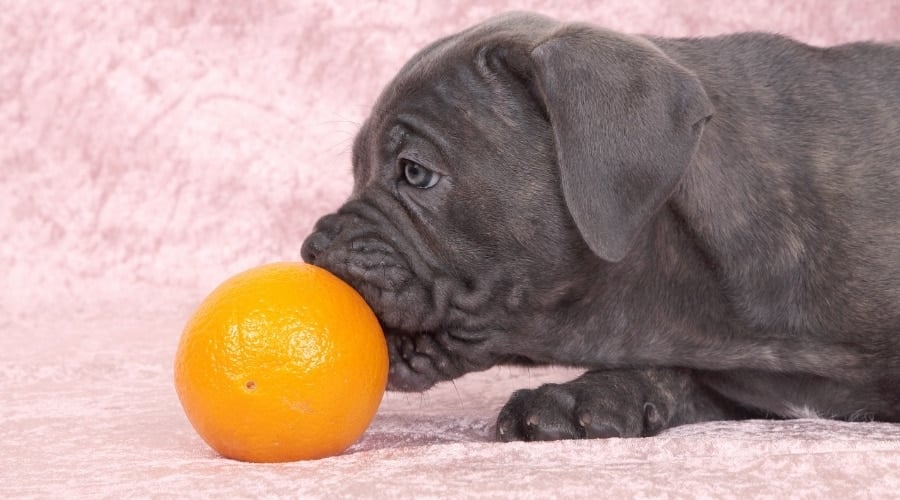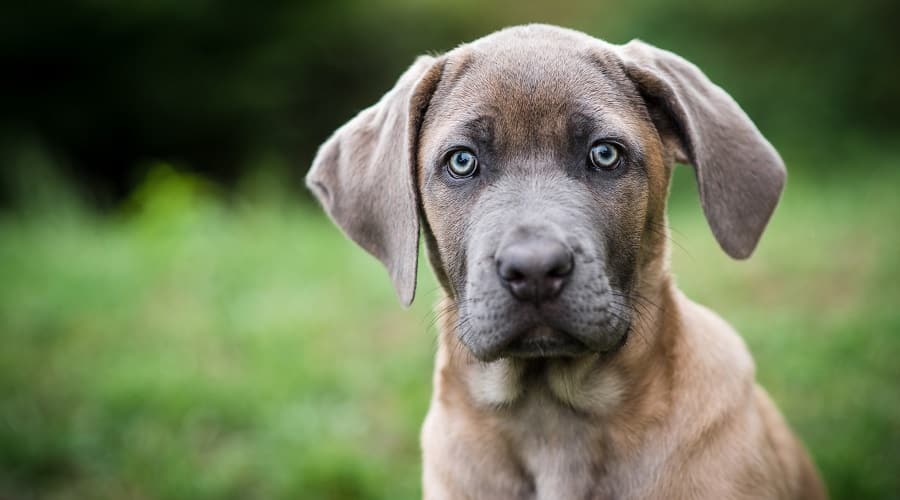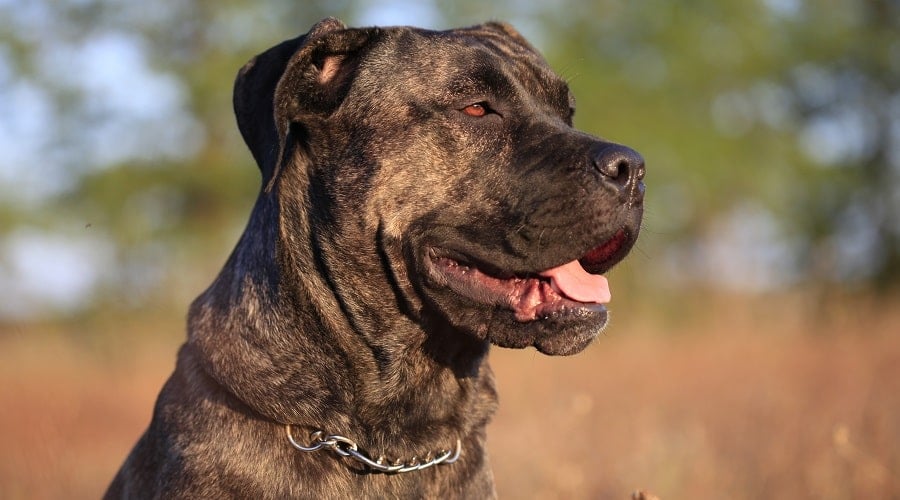The Cane Corso is one of America’s most popular large dog breeds. Not only are they incredible guard dogs, but they also make sweet family companions. The American Kennel Club (AKC) describes them as intelligent, affectionate, and majestic pups. They are formidable-looking dogs with muscular bodies, square heads, and large imposing eyes. They weigh up to 100 pounds and stand up to 28 inches tall.
In contrast to their rugged appearance, they sport a wonderfully thick and glossy coat, which comes in various color shades with different markings. According to their breed standard, there are seven Cane Corso coat colors: black, black brindle, gray, gray brindle, red, fawn (yellow), and chestnut brindle. Some coat colors are more common than others, and some colors are unacceptable in the show ring. We explore everything you need to know about their coat coloring.
There are also some colors that Cane Corso breeders promote as rare or desirable, but they aren’t in the breed standard. Does it matter what color they are? If their color isn’t in the breed standard, they might not be a purebred Cane Corso. Plus, if they’re bred for their coat color over their health, you could find yourself with a sick pup. So let’s dive into the world of Cane Corso colors.
Cane Corso Breed Standard

The AKC is the leading kennel club in America, and they recognize seven Cane Corso colors as standard. The United Kennel Club and the Federation Cynologique (FCI), the main kennel club in Europe, have slightly different color guidelines. Here’s what the AKC’s Cane Corso breed standard specifies about their coat colors:
Acceptable Cane Corso colors include black, red, light and dark gray, and light and dark yellow (aka fawn). Brindling is allowed on all of these colors. Solid fawn and red Cane’s have black or gray mask that does not show up beyond the eyes. There can be a patch of white in various spots such as the chin, throat, chest, backs of the front legs, and toes. Any color with tan pattern markings is disqualified from the AKC’s standards.
In certain circumstances, the color of a dog’s coat is essential, and one of those occasions is if you plan to show your dog in the conformation ring. If you do, you need to check the kennel guidelines about what colors they accept. Remembering that each club has slightly different policies. If not, their coat color is not that important as long as they are healthy.
Standard Cane Corso Colors
Black

A black Cane Corso coat is the most common, but one of the most stunning, too, thanks to its shine. Additionally, there’s something intimidating about a large, protective dog with a jet-black coat and dark, watchful eyes, which is why it is a popular color for those looking for a protective guard dog. Unfortunately, many black Cane Corsos have white patches in the wrong places, making them ineligible for show.
Gray

Gray Cane Corsos are also very popular but rarer than black Cane Corsos. This is because both parents need to carry a rare recessive dilute gene. And even then, a gray puppy is not certain. Many gray puppies change color slightly and can develop a brindle pattern too.
There is a lot of confusion about whether or not blue Cane Corsos exist. And they do exist, but they are referred to as gray Corsos. The confusion comes from the breed standard. Instead of calling a diluted black coat blue, they have termed it gray. It would be best to avoid any breeder claiming they are a rare blue Corso.
Fawn

A fawn-colored Cane Corso coat can range from light cream to a deep tan. They have a gray or black mask, but the darker mask must not go beyond their eyes. Fawn Cane Corso are often mistaken for Mastiffs or Boerboels thanks to their similar coloring and frame.
Black Brindle

A black brindle Cane Corso has a brown or red base coat with black stripes, much like a tiger. This is another popular coat option for those seeking a fierce color.
Gray Brindle
A gray brindle Cane Corso also has a brown base color, but this time with gray stripes. Like the black brindle coat, it is an attractive and popular choice. Brindle coats are trendy because of their uniqueness, and you’ll certainly stand out from the Corso crowd with a brindle pup.
Red

Red Cane Corsos are often confused for fawn ones, but their tone is very different when you look closely. Some red Corsos are pale yellow in color or deep brown.
Chestnut Brindle

Chesnut brindles are similar to black brindles because they have the same brown or red base coat. But instead, their stripes are red to reddish brown instead of black. The stripes vary in color, and some can be very light while others are very dark.
Non-Standard Cane Corso Colors
Here are some of the colors in the Cane Corso breed that are not accepted by kennel clubs.
Formentino
Formentinos have a diluted fawn color coat with a brown and gray tone. Some can have a very light coat color but differ from straw-colored Corsos. They also have a gray mask and some gray markings on their back.
Liver/Chocolate
Liver coat colors are sometimes called chocolate coats and are also confused for red or chestnut brindle. Although they look similar, the difference comes with their eyes and noses, which have no pigmentation. They can also have lighter-colored eyes, which are undesirable according to the proper Cane Corso standard.
Isabella/Tawny
Isabella Cane Corsos are a dilute liver color, which makes them appear almost lilac in tone. Their nose and eyes are also lighter in color, almost pinky lilac. There are rare and also considered a fault by kennel clubs, as they result from a gene mutation and are usually bred for color over health.
Straw
Straw is the rarest Cane Corso color, and they appear cream. They are sometimes referred to as the magnificent cream or white Corsos. Don’t mistake these for albino Cane Corsos. These pups have a slight pigmentation to their coat and dark-colored features that albino dogs do not.
Frequently Asked Questions
What Cane Corso Color Is Right For Me?
There are many Cane Corso coat colors to choose from, so unlike many other breeds, you are spoiled for choice. If you want to enter your pup into a competition, the right color is one of the colors in the breed standard. If you don’t intend to show your dog, the color of your pup doesn’t matter all that much. As long as they are healthy Cane Corsos, that’s all that matters.
Do Cane Corso Change Color?
Like many other breeds, a puppy’s coat can change color slightly as they mature. There are many reasons why this might happen, such as diet, medications, skin disease, and sunlight for example, which can all affect the color and quality of a dog’s coat. For example, a puppy born with a black coat might become lighter, turning to dark gray. But a Cane Corso coat won’t completely change from fawn to black, for example.
What Is The Rarest Cane Corso Color?
The rarest Cane Corso colors are the non-standard ones. Not only because they are non-standard colors but also because their coat color results from a recessive gene, which is also rare. The most common Cane Corso color is black.
What Color Cane Corso Lives The Longest?
The average lifespan of a Cane Corso is between 9 and 12 years. Responsible breeders breed for health rather than appearance and color and therefore tend to produce healthier pups. Therefore, Cane Corso sporting non-standard colors are more often than not bred for color rather than health. This increases their chances of developing health issues such as color dilution alopecia, deafness, eye abnormalities, skin diseases, and cancer. The chances are that a Cane Corso with a standard coat color is likely to be healthier.
Final Thoughts
Now you know which Cane Corso colors are standard and accepted by the AKC and the rarer non-standard colors found in their bloodline. If you come across a Cane Corso in any other color, you can be sure they are not a purebred Cane Corso. Always research your breeder thoroughly. It’s essential to choose a puppy based on health rather than color. But no matter what color you choose, they are all as gorgeous as each other.





